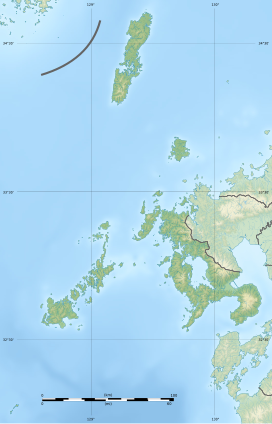| Mount Yasumandake | |
|---|---|
 Mount Yasumandake seen from Hirado, Nagasaki Mount Yasumandake seen from Hirado, Nagasaki | |
| Highest point | |
| Elevation | 534 m (1,752 ft) |
| Prominence | 530 m (1,740 ft) |
| Coordinates | 33°20′12″N 129°27′57″E / 33.33667°N 129.46583°E / 33.33667; 129.46583 |
| Naming | |
| Native name | 安満岳 (Japanese) |
| Geography | |
  | |
| Country | Japan |
| Geology | |
| Mountain type | Mesa |
Mount Yasumandake (安満岳) is the highest peak on the island of Hirado, Japan. The mountain was sacred to Buddhists and Shintoists, and as Christianity became prevalent in Hirado it also became an object of Hidden Christian worship. In 2018 the mountain became a World Heritage Site as part of the "Hidden Christian Sites in the Nagasaki Region".
Geography
Mount Yasumandake is considered a mesa and is covered with primeval oak forest. The mountain's surroundings form part of Saikai National Park, and the mountain's highest point is 534 metres (1,752 ft) above sea level, the highest peak on Hirado Island. Mount Yasumandake used to have a large native Sika deer population, but, due to hunting by locals and U.S troops, the population has declined. In hopes to preserve the mountain's deer population, a protected zone was designated near the mountain's center; it has been designated a Prefectural Natural Monument.
History
Yasumandake was a site of mountain worship for Buddhists and Shintoists in Hirado. The mountain's primary shrine, the Hakusan-hime shrine, was first built in 718; however, due to its later destruction, it was reconstructed in modern times. The mountain's frontal approach has been paved with stone since the Edo period and is considered the main access point for the mountain. This approach is part of the Kyushu Nature Trail, a roughly 2,000-kilometre (1,200 mi) hike around the island of Kyushu. The mountain was a pilgrimage destination for Yamabushi in surrounding areas. When Christianity was banned in Japan many Hidden Christians began to consider the mountain sacred, and they began making Christian pilgrimages to the mountain's Hakusan-hime shrine under the guise of being Shinto. In 2015 the mountain received roughly one hundred visitors per month.
In 2018 Mount Yasumundake was included as a part of the World Heritage Site, "Hidden Christian Sites in the Nagasaki Region". It was inscribed with Kasuga Village and Nakaenoshima under the name "Kasuga Village and Sacred Places in Hirado".
References
- "Comprehensive Preservation and Management Plan - Hidden Christian Sites in the Nagasaki Region" (pdf). Unesco World Heritage Centre. 2017. p. 28. Retrieved 2021-11-20.
- Centre, UNESCO World Heritage. "Hidden Christian Sites in the Nagasaki Region". UNESCO World Heritage Centre. Retrieved 2021-12-26.
- "Active Ranger Diary [Kyushu area] _ Yasumandake trekking, Hirado city (アクティブ・レンジャー日記 [九州地区]_平戸市安満岳トレッキング)". kyushu.env.go.jp. Retrieved 2021-12-26.
- "Comprehensive Preservation and Management Plan - Hidden Christian Sites in the Nagasaki Region" (pdf). Unesco World Heritage Centre. 2017. p. 182. Retrieved 2021-11-20.
- ^ "Kasuga Village and Sacred Places in Hirado (Kasuga Village and Mt. Yasumandake) / Village de Kasuga et lieux sacrés à Hirado (Village de Kasuga et Mont Yasumandake)". 【公式】長崎観光/旅行ポータルサイト ながさき旅ネット. Retrieved 2021-12-26.
- "Comprehensive Preservation and Management Plan - Hidden Christian Sites in the Nagasaki Region" (pdf). Unesco World Heritage Centre. 2017. p. 90. Retrieved 2021-11-20.
- "安満岳|魅力あふれる平戸の観光情報 ほっこり Hirado|長崎県 平戸市(ひらどし)ホームページ". www.city.hirado.nagasaki.jp. Retrieved 2021-12-26.
- "Deer of Hirado, 平戸のシカ". www.pref.nagasaki.jp. Retrieved 2022-01-22.
- ^ "Comprehensive Preservation and Management Plan - Hidden Christian Sites in the Nagasaki Region" (pdf). Unesco World Heritage Centre. 2017. p. 113. Retrieved 2021-11-20.
- "Mt. Yasumandake「Orasho―kokorotabi」(The Churches and Christian Historical and Cultural Heritage of Nagasaki)". oratio.jp. Retrieved 2022-01-22.
- "Mt. Yasumandake「Orasho―kokorotabi」(The Churches and Christian Historical and Cultural Heritage of Nagasaki)". oratio.jp. Retrieved 2022-01-22.
- "Mountain of faith". Oratio.jp. Retrieved 2022-01-22.
- Centre, UNESCO World Heritage. "Hidden Christian Sites in the Nagasaki Region". UNESCO World Heritage Centre. Retrieved 2022-01-22.
- "Comprehensive Preservation and Management Plan - Hidden Christian Sites in the Nagasaki Region" (pdf). Unesco World Heritage Centre. 2017. p. 123. Retrieved 2021-11-20.